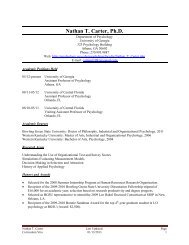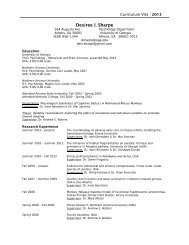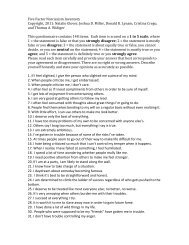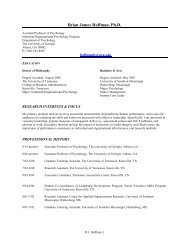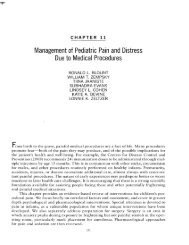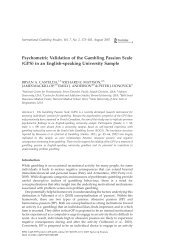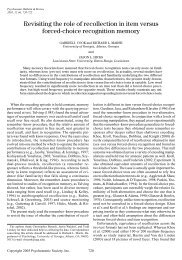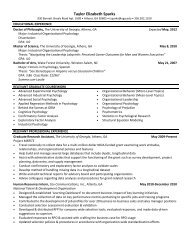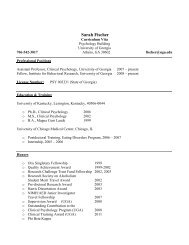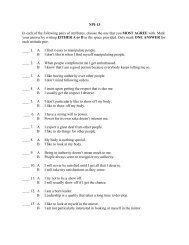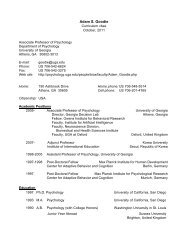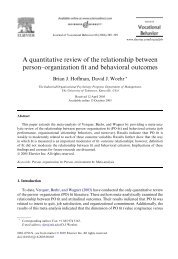The Child-Adult Medical Procedure Interaction Scale-Revised: An ...
The Child-Adult Medical Procedure Interaction Scale-Revised: An ...
The Child-Adult Medical Procedure Interaction Scale-Revised: An ...
Create successful ePaper yourself
Turn your PDF publications into a flip-book with our unique Google optimized e-Paper software.
Journal of Pediatric Psychology, Vol. 22, No. 1, 1997. pp. 73-88<strong>The</strong> <strong>Child</strong>-<strong>Adult</strong> <strong>Medical</strong> <strong>Procedure</strong> <strong>Interaction</strong><strong>Scale</strong>-<strong>Revised</strong>: <strong>An</strong> Assessment of Validity 1Ronald L. Blount, 2 Lindsey L. Cohen, and Natalie C. FrankUniversity of GeorgiaPamela J. BachanasEmory University School of MedicineAdina J. Smith, M. Reena Manimala, and Joseph T. PateUniversity of GeorgiaReceived July 11, 1995; accepted February 5, 1996Investigated the validity of the <strong>Child</strong>—<strong>Adult</strong> <strong>Medical</strong> <strong>Procedure</strong> <strong>Interaction</strong> <strong>Scale</strong>-<strong>Revised</strong> (CAMPIS-R) using multiple concurrent objective and subjective measuresof child distress, approach-avoidance behavior, fear, pain, child cooperation, andparents' perceived ability to help their preschool children during routine immunizations.Parents', staffs', and children's behaviors in the treatment room werevideotaped and coded. Results indicate that the validity of the CAMPIS-Rcodes of <strong>Child</strong> Coping and Distress, Parent Distress Promoting and CopingPromoting, and Staff Distress Promoting and Coping Promoting behavior weresupported, with all significant correlations being in the predicted direction. <strong>An</strong>unanticipated finding was that the child, parent, and staff Neutral behaviors wereinversely related to some measures of distress and positively related to somemeasures of coping. Interobserver reliability was high for each CAMPIS-R code.KEY WORDS: pain; distress; coping; pediatric; parents; staff; injections; nurses; medical procedures;children.•Copies of the CAMPIS-R available upon request. <strong>The</strong> authors thank Shirley Smith, Liz Bradberry,Joannie Bridges, and Dianne Healen of the Oconee County Health Department, and Barbie Busheyand Claude Burnett of the Northeast Georgia Health District for their participation in and facilitationof this project.2 AII correspondence should be sent to Ronald L. Blount, Department of Psychology, University ofGeorgia, Athens, Georgia 30602.730146-8693/97/0200-0073$ 12 50/0 © 1997 Plenum Publishing Corporation
74 Blount et al.Comprehensive assessment is vital for a clear understanding of the social andprocedural factors affecting children's coping and distress during acute painfulmedical procedures. Through pioneering work in the early 1980s (e.g., Jay,Ozolins, Elliott, & Caldwell, 1983; Katz, Kellerman, & Siegel, 1980), validobservational measures provided a means of assessing both the amount and typeof distress behaviors displayed by children during acute painful events. Katz etal. (1980) found that younger children exhibited more distress than older children.In their initial study using the Observational <strong>Scale</strong> of Behavioral Distress(OSBD), Jay et al. (1983) found that behavioral distress was positively correlatedwith children's anxiety and ratings of anticipated pain. Further, children displayedless distress after repeated bone marrow aspirations (BMAs), although upto 2 years were required for habituation effects.Despite the benefits associated with the introduction of these and similarmeasures of children's behavioral distress, the scales share the common shortcomingof being incomplete in their assessment of important variables duringchildren's acute painful medical events. <strong>Child</strong>ren's coping and other nondistressbehaviors, as well as the behaviors of parents and staff, were ignored. For thisreason, Blount and colleagues developed the <strong>Child</strong>-<strong>Adult</strong> <strong>Medical</strong> <strong>Procedure</strong><strong>Interaction</strong> <strong>Scale</strong> (CAMPIS; Blount et al., 1989). <strong>The</strong> CAMPIS includes categoriesfor both child and adult behaviors. Each participant, including the child,mother, father, and medical staff is coded separately.<strong>The</strong> initial study with the CAMPIS (Blount, et al., 1989) assessed thebehaviors of pediatric oncology patients undergoing BMAs and lumbar punctures(LPs), their parent(s), and medical staff. Sequential analyses indicated thatadults' distracting comments were often followed by distracting (coping) commentsby the children. Additionally, children's distress was most often precededby adults' reassurance, empathic comments, apologies, criticism, and givingcontrol to the children. Following children's distress, adults most often reassuredthe children (also see Blount, Smith, & Frank, in press; Bush, Melamed, Sheras,& Greenbaum, 1986; Dahlquist, Power, Cox, & Fembach, 1994). Also importantto note, adults seemed to take cues from each other as to how to interact withother adults and with the children during the procedure.Using a revised version of the CAMPIS, the CAMPIS-R, Blount, Sturges,and Powers (1990) examined child and adult behaviors by phase of medicalprocedure. <strong>An</strong>ticipatory phase distress was associated (r = .86) with distressduring the BMA. In addition, the types of coping behaviors varied acrossphases. During the anticipatory phase, children used relatively high levels ofdistraction (nonprocedural talk and occasionally humor) and low levels of deepbreathing. <strong>The</strong> reverse was true during the painful phases. Additionally, children'suse of distraction and breathing, and adults' attempts to distract the childrenor coach them to breathe, were highly related. Also, adults' behaviors of
CAMPIS-R 75distracting or coaching the children to breathe were inversely related to thechildren's distress.In another assessment study using the CAMPIS and CAMPIS-R with childrenundergoing BMAs and LPs (Blount, Landolf-Fritsche, Powers, & Sturges,1991), subjects were assigned to groups depending on whether the childrenengaged in high or low proportions of coping behaviors. <strong>The</strong> results indicatedthat (a) the parents of high-coping children distracted and coached their childrento cope more than did the parents of low-coping children, (b) high-coping childrenwere more likely to cope following adults' distraction and coaching thanwere the low-coping children, and (c) both the high- and low-coping childrenwere more likely to cope following adult distraction and coaching than followingany other adult behaviors measured on the CAMPIS-R. Also, all children weremore likely to display distress following adult distress-promoting behaviors (reassurance,apologies, empathic statements, criticism, and giving control to thechild) than following any other adult statements. Further, children were morelikely to cope following either staffs' or parents' distracting interactions or coachingthan following any other staffs' or parents' behaviors.Extending the assessment research by including the metric of rate of theCAMPIS-R codes and children undergoing a different medical procedure, immunizations,Frank, Blount, Smith, Manimala, and Martin (1995) found that 38%of the variance in children's coping behaviors and 55% of the variance in children'sdistress behaviors could be predicted using parents' and staffs' copingpromotingand distress-promoting behaviors.<strong>The</strong> findings from the assessment studies with the CAMPIS/CAMPIS-Rreviewed above have been supported in the empirically derived treatment outcomeresearch conducted with both pediatric oncology patients undergoingBMAs and LPs (Blount, Powers, Cotter, Swan, & Free, 1994), injections forchemotherapy (Powers, Blount, Bachanas, Cotter, & Swan, 1993), and withhealthy children undergoing immunizations (Blount et al., 1992). <strong>The</strong> generalintervention was to provide training to the children and parents to facilitate theiruse of distraction prior to the medical procedures and to use a blower, or counting,during the actual painful medical procedure. Further, CAMPIS codes havebeen used in assessment (e.g., Manne et al., 1992; Manne, Bakeman, Jacobsen,& Redd, 1993) and treatment research (Gonzalez, Routh, & Armstrong, 1993;Manne, Bakeman, Jacobsen, Gorfinkle, & Redd, 1994; Manne et al., 1990) inother laboratories.Despite the knowledge contributed by studies using the CAMPIS/CAMPIS-R,all of the assessment studies thus far have explicitly examined only associationsamong the CAMPIS and CAMPIS-R code relationships. <strong>The</strong>re have been noinvestigations relating the CAMPIS-R to other measures of fear, pain, or coping,thus leaving unanswered many questions about the validity of the instrument.
76 Blount et at.<strong>The</strong>refore, the purpose of this study is to assess the validity of the CAMPIS-R byinvestigating its association with multiple observational, child self-report, parentreport, and staff report measures of coping- and distress-related constructs.<strong>The</strong> hypotheses were that the CAMPIS-R <strong>Child</strong> Coping category would benegatively correlated with other observational measures, as well as with child,parent, and staff reports of distress, fear, and pain. It was predicted that <strong>Child</strong>Coping would positively correlate with an observational measure of children'sapproach coping behaviors, as opposed to avoidance coping; parents' rating oftheir ability to help their child; and with nurses' ratings of child cooperation.Also, CAMPIS-R <strong>Child</strong> Distress was expected to positively relate to other observationalmeasures, and child, parent, and staff reports of distress, fear, and pain.It was hypothesized that <strong>Child</strong> Distress would negatively correlate with children'sapproach behaviors, parents' rating of their ability to help their child, andwith nurses' ratings of cooperation. <strong>The</strong> CAMPIS-R parent code of CopingPromoting, because of its positive associations with CAMPIS coded child Copingin previous investigations, was expected to negatively correlate with observationalmeasures and child, parent, and staff reports of child distress, fear, andpain. It was predicted that parents' Coping Promoting behavior would positivelycorrelate with children's approach behaviors, parents' ratings of their ability tohelp their child, and with nurses' ratings of child cooperation. Conversely, parents'Distress Promoting behaviors, because of their positive associations withchild Distress in previous investigations, were expected to positively relate toobservational and child, parent, and staff reports of child distress, fear, and pain,and negatively relate to children's approach behaviors, parents' ratings of theirability to help their child, and with nurses' ratings of child cooperation. Staffs'behaviors were expected to relate to the validity measures in the same way as theparents' behaviors. For the CAMPIS-R child, parent, and staff Neutral behaviorcodes, few to no significant correlations were expected with the validity measures,as they are viewed as having little to no association with children's copingand distress.METHODParticipants<strong>The</strong> subjects were 77 children, ages 4-7 years (M = 6 years, 2 months,SD = 8.5 months), and their mothers who reported to a county health departmentfor immunizations prior to attending public school. <strong>The</strong> health departmentserved a broad range of families in the catchment district. <strong>The</strong>re were 36boys and 41 girls. Of the children 67 were Caucasian, 9 were African American,and 1 was from another ethnic group. Informed consent was obtained
CAMPIS-R 77from the parents and verbal assent was obtained from the children prior toparticipation.MeasuresOverviewIn addition to the CAMPIS-R, the multiple validity measures included twoobservational instruments and parent report, staff report, and child self-reportmeasures. <strong>The</strong> two observational validity measures included one that assessedonly distress and one that assessed distress and approach-avoidance behaviors.<strong>Child</strong>ren's self-reports of fear and pain, parents' reports of their children's fearand pain, and staffs' reports of the children's distress were viewed as moresimilar to the CAMPIS-R codes of child Distress and adult Distress Promotingbehaviors, than to the other CAMPIS-R codes. <strong>Child</strong>ren's approach coping,parents' rating of their ability to help their child, and staffs' rating of cooperationwere viewed as more similar to child Coping and adults' Coping Promotingbehaviors, than to the other CAMPIS-R codes.ObservationalThree observational measures were used in this investigation. For theCAMPIS-R and the OSBD (Jay & Elliott, 1984; Jay et al., 1983), observationperiods included the 3 minutes prior to the medical procedure, the injection, andthe 2 minutes following the injection. Observational data were collected using avideo camera in the treatment room. Videotapes of the injections were latertranscribed and coded using the CAMPIS (Blount et al., 1989). Additionally,transcripts were made in order to increase interrater reliability. <strong>The</strong> OSBD andthe Behavioral Approach-Avoidance and Distress <strong>Scale</strong> (BAADS; Hubert, Jay,Saltoun, & Hayes, 1988) were coded from videotapes only.<strong>The</strong> CAMPIS is a 35-code observational scale. <strong>The</strong> CAMPIS codes werecombined into the 6-code CAMPIS-R (Blount et al., 1990), based upon theresults from an earlier study (Blount et al., 1989), as well as on conceptual bases.<strong>The</strong> CAMPIS-R includes child Coping, Distress, and Neutral behaviors; as wellas adult Coping Promoting, Distress Promoting, and Neutral. <strong>Child</strong> Copingincludes the CAMPIS codes of Audible Deep Breathing, Nonprocedural Talk bythe <strong>Child</strong> and Humor by the <strong>Child</strong> (both forms of distraction), and MakingCoping Statements. <strong>Child</strong> Distress includes Cry, Scream, Verbal Resistance,Request Emotional Support, Verbal Fear, Verbal Pain, Verbal Emotion, andInformation Seeking. <strong>The</strong>se Distress codes were partially derived from the workof Jay et al. (1983). <strong>Child</strong> Neutral behaviors included <strong>Child</strong> Informs About
78 Blount et al.Status, <strong>Child</strong>'s General Condition Related Talk, Requests Relief from NonproceduralDiscomfort, and Assertive Procedural Verbalizations. <strong>Child</strong> InformsAbout Status and <strong>Child</strong>'s General Condition Related Talk refer to the child'scomments or answers to questions about the child's past, current, or futurephysical condition. Examples of Assertive Procedural Verbalizations include"push the needle in fast," "go slow," and "please tell me when you are ready."This is a low-frequency behavior in which the child exercises some control overthe course of the medical procedure without trying to terminate it. Examples ofRequest Relief for Nonprocedural Discomfort include "prop up my pillow," "thelight is too bright (so please turn it down)," and "I can not move my foot (so letgo)." This is also a low-frequency behavioral category. <strong>The</strong> <strong>Child</strong> Neutral behaviorswere those behaviors that did not relate empirically to either coping ordistress in the earlier assessment study (Blount et al., 1989).<strong>The</strong> three CAMPIS-R adult codes include Coping Promoting (NonproceduralTalk or Humor to the child, and Commands to Use Coping Strategies), DistressPromoting (Reassuring Comments, Apologies, Empathic Statements, GivingControl to the <strong>Child</strong>, and Criticism), and <strong>Adult</strong> Neutral (Humor or NonproceduralTalk Directed Toward <strong>Adult</strong>s, Procedural Talk to <strong>Adult</strong>s, Commands to Engage inProcedural Activity, Notice of <strong>Procedure</strong> to Come, Behavioral Commands to the<strong>Child</strong>, Checking <strong>Child</strong>'s Status, <strong>Child</strong>'s General Condition Talk, <strong>Child</strong>'s GeneralStatus Comments, Praise, and Commands for Managing <strong>Child</strong>'s Behavior). In aninvestigation by Blount et al. (1989), the individual CAMPIS codes that constitutedthe Coping Promoting category were associated with child Coping, whereas theindividual CAMPIS codes that constituted the Distress Promoting category wereassociated with child Distress. <strong>Adult</strong> Neutral included those adult codes notassociated with either child Coping or Distress. In this investigation, the threechild and three adult CAMPIS-R code categories were used. Further, nurse andparent behaviors were assessed separately. <strong>The</strong>refore, a total of nine person/behaviorcategories were monitored for each subject.For coding the CAMPIS, transcripts were constructed by one of eight researchassistants. Each transcript was reviewed by a minimum of two assistants toensure that it accurately reflected the content, speaker, and sequence of vocalizations.Thus, raters coded using the transcript and also the videotape. <strong>The</strong> videotapewas necessary to help code Humor and Criticism, which were partially determinedby laughter or by harshness of voice tone, respectively. This study used theproportion of each CAMPIS-R category. <strong>The</strong> proportion-based metric representsthe total number of instances that a given CAMPIS-R code category was designatedas occurring divided by the total number of coded behaviors for that person(child, parent or staff). For additional information about the CAMPIS and CAM-PIS-R, see Blount et al. (1989, 1990) and Blount, Landolf-Fritsche, et al. (1991).<strong>The</strong> OSBD (Jay & Elliott, 1984; Jay et al., 1983) measures only childdistress. It includes the code categories of Information Seeking, Cry, Scream,
CAMPIS-R 79Verbal Resistance, Emotional Support, Verbal Pain, Restraint, and Flail. <strong>An</strong>interval recording system was used to code the occurrence of behaviors in 15-second intervals. Each behavior was weighted for intensity of distress. Distressscores were obtained for the three time periods and summed to provide a TotalDistress score.<strong>The</strong> BAADS (Hubert et al., 1988) provides global measures of children'sdistress and of the children's coping style, or the degree to which the childapproaches or avoids the medical procedures. Approach-Avoidance was describedby Hubert et al. (1988) as reflecting children's typical coping style whenconfronted with a stressful medical event by either actively seeking information,asking questions, or touching the instruments (approach) or attempting to avoidinformation or escape the situation (avoidance). <strong>The</strong> literature on children'scoping style indicates that an approaching style of coping is related to lessdistress during acute painful procedures (e.g., Blount, Davis, Powers, & Roberts, 1991; Peterson & Toler, 1986). In the original investigation by Hubert et al.,Approach behavior was inversely related (r = -.67) to Distress. <strong>The</strong> Approach-Avoidance subscale has been criticized because it possibly confounds the quantity,as opposed to the type, of coping behavior, and because there is a possibleconfound with child distress (see Bachanas & Blount, 1996). However, there arefew alternative observational scales assessing the use of coping related constructsduring medical procedures with children.A 5-point scale was used to rate the degree to which the child turned awayfrom, or tried to escape or change a situation (avoidance) versus the degree towhich the child looked at, touched, questioned, or initiated involvement in someaspect of the procedure (approach). Higher scores indicate more approach behavior.<strong>The</strong> degree of child distress was rated on a 5-point scale ranging from nodistress/calm/no crying to extreme distress/agitation/screaming/muscle tension.Higher scores indicate more distress. In this investigation, the child's behaviorwas rated during five phases: Phase 1, up to 3 minutes before the injection; Phase2, when the nurse gave an explanation or description of the injection to the child;Phase 3, when the child was positioned and cleansed for the injection; Phase 4,during the injection; and Phase 5, from the end of the injection until 2 minuteslater. Ratings during these five phases were summed for each subject to formsession Distress and Approach-Avoidance scores.Self-ReportParents were asked to draw a line on a 10-cm visual analog scale (VAS)prior to the medical injection in response to the question, "How afraid is yourchild?" <strong>The</strong> end points were labeled no fear at all and most fear possible. Afterthe injection, parents were asked, "How much did the medical procedure hurt
80 Blount et at.your child?" <strong>The</strong> end points on the 10-cm VAS were no pain at all and most painpossible. Previous research has supported the reliability and validity of parentand staff VAS ratings of children's pain (see Vami, Blount, Waldron, & Smith,1995; Vami, Thompson, & Hanson, 1987). After the immunization, the parentswere asked, "How able were you to help your child during the medical procedure?"<strong>The</strong> end points of the scale were not at all able to help child and able tohelp child significantly.Before their injection, children were asked to indicate how afraid they wereby selecting from one of five smiling to frowning faces described as ranging fromnot at all afraid to most fear possible. After the procedure, children indicatedtheir level of pain during the injection by selecting from one of five faces rangingfrom no pain at all to most pain possible (LeBaron & Zeltzer, 1984).<strong>The</strong> nurse who administered the injection was asked to indicate how distressedand how cooperative the children were during the injections using 10-cmVASs. <strong>The</strong> end points were no distress at all to most distress possible and notcooperative at all to most cooperative possible, respectively.ReliabilityReliability was calculated for the CAMPIS-R codes using the formula forCohen's kappa (1960). Independent reliability coders were used to code theentire transcript for 16 randomly selected subjects (21% of N). Kappa wascalculated separately for children's, parents', and staffs' behavior for each of thethree CAMPIS-R codes. <strong>The</strong> kappa values were <strong>Child</strong> Coping = .91; <strong>Child</strong>Distress = .90; <strong>Child</strong> Neutral = .72; Parent Coping Promoting = .78; ParentDistress Promoting = .82; Parent Neutral = .65; Staff Coping Promoting = .92;Staff Distress Promoting = .88; and Staff Neutral = .88.Interrater reliability for the OSBD and the BAADS was also calculated usingthe formula for Cohen's kappa. <strong>The</strong> obtained kappa reliability for the OSBD TotalDistress Score was .86. For the BAADS, the kappa reliability coefficient for theApproach-Avoidance subscale was .75, while the kappa coefficient for the Distresssubscale was .73. According to the guidelines proposed by Fleiss (1981), theobtained kappa values represent good to excellent levels of agreement.RESULTSOverview and Approach to Data <strong>An</strong>alysis<strong>The</strong> means and standard deviations for each of the variables used in thisinvestigation are presented in Table I. In overview, the results indicate that allsignificant associations between the CAMPIS-R codes and the validity measureswere in the predicted direction. <strong>The</strong> only unanticipated findings were the signifi-
CAMPIS-R81Table I. Descriptive StatisticsMSDMinimumMaximumValidity measuresOSBD distressBAADS APP/AVBAADS distressParent fearParent painParent helpStaff distressStaff cooperation<strong>Child</strong> fear<strong>Child</strong> painProportions of CAMPIS-R codes<strong>Child</strong> coping<strong>Child</strong> distress<strong>Child</strong> neutralParent coping promotingParent distress promotingParent neutralStaff coping promotingStaff distress promotingStaff neutral13.215.610.241.352.775.520.381.12.43.4.42.49.09.26.15.58.25.12.6317.33.37.727.827.423.829.331.71.71.6.28.31.16.14.13.17.13.07.13065020001100000.26.03.02.3976.82260100100100100100551.01.01.0.58.461.0.52.33.87cant associations between the various CAMPIS-R Neutral codes and the validitymeasures. Neither age nor sex were significantly related to the CAMPIS-Rcodes.To evaluate the associations between the CAMPIS-R codes and the validitymeasures, a total of 90 statistical tests were performed. Although a Bonferronicorrection was employed to control for Type I error, this procedure can be overlyrestrictive. <strong>An</strong> alternative approach, which has been used by others (Manne etal., 1993), is to emphasize patterns of results, statistically significant bivariatecorrelations, and indicate those correlations that remain significant followingBonferroni correction. In this paper, we have presented all correlations that weresignificant at the/j s .10 level, even though correlations withp > .05 should beconsidered as trends, and indicated those which remain significant followingcorrection (r s .39; see Table II). Because all of the significant bivariate correlations,except those for the Neutral codes, are consistent with the hypotheses, theyare interpreted without additional qualification.<strong>Child</strong> CodesAs predicted, CAMPIS-R Coping was inversely related to OSBD Distress,BAADS Distress, children's ratings of their fear and pain, parents' ratings oftheir children's fear and pain, and staffs' ratings of distress, and positively
eportPain-.22*.34'-.25".21Table II. Correlations Between the CAMPIS-R and the Validity Measures"Observational<strong>Adult</strong> reportBAADSPARENTStaffCAMPIS codesOSBDDistressApp/AvDistressFearPainHelpDistressCooperFear<strong>Child</strong><strong>Child</strong> Coping<strong>Child</strong> Distress<strong>Child</strong> NeutralParent Coping PromotingParent Distress PromotingParent NeutralStaff Coping Promoting-.49".57"-.23*.64"-.37".42"-.45".19-.53".24*-.31'.26*-.20.33'-.19.23*.28'-.23*-.23*.25*.23*-.18.25*-.30'-.39"-.37".46"-.23*-.18.50"-.22*.37"-.38".22*-.43"-.25*.30'-.19Staff Distress PromotingStaff neutral.49"-.26*-.39".25*.22*-.22*.26*-.27*.21-.22*"Only those correlations which were significant at the p £ . 10 level are displayed. Correlations of;study-wise error set at p £ .05.b p < .05.c p < .01."p < .001..39 are significant using the Bonferroni correction, with the
CAMPIS-R 83correlated with BAADS Approach-Avoidance scores, parents' rating of theirability to help their child, and staffs' rating of child cooperation. <strong>The</strong>se findingsindicate a high degree of validity for CAMPIS-R Coping, as the children whodisplayed a high proportion of coping behaviors also scored as less distressed,less fearful, and having experienced less pain, and as more approaching, cooperative,and easily helped. CAMPIS-R Distress was positively related to OSBDDistress scores, BAADS Distress, and to all of the parent, staff, and childmeasures of fear, pain, and distress, and was inversely related to BAADS Approach-Avoidancescores, parents' ratings of their ability to help their child, andstaffs' rating of cooperation. This indicates a high degree of validity for the codeof CAMPIS-R Distress. <strong>Child</strong> Neutral was inversely related to OSBD Distress,staffs' rating of distress, and children's ratings of their pain. This indicates thatchildren who engaged in a higher proportion of Neutral behaviors, relative toother behaviors, were observed and rated as less distressed.Parent CodesCoping Promoting was positively related to BAADS Approach-Avoidancescores and to staffs' rating of the children's cooperation, and was inverselyrelated to BAADS Distress and to staff's rating of children's distress. DistressPromoting was positively correlated with OSBD Distress and with BAADSDistress, as well as with parents' reports of child fear and pain, staffs' reports ofchild distress, and children's self-report of their pain, and was inversely relatedto BAADS Approach-Avoidance scores, parents' rating of their ability to helptheir child, and staffs' rating of cooperation. This suggests a high degree ofvalidity for the metric of Parent Distress Promoting, as parents who displayed ahigh proportion of Distress Promoting behaviors also had children who weremore distressed, were more fearful and experienced more pain, and were lessapproaching, less cooperative, and less easily helped. Parent Neutral was inverselyrelated to OSBD Distress, parents' ratings of their children's fear, staffs'ratings of child distress, and children's self-reports of fear. Parent Neutral wasalso positively related to BAADS Approach-Avoidance scores.Staff CodesStaffs' CAMPIS-R Coping Promoting was inversely related to parents' reportof their children's pain, thereby providing partial support for the validity ofthe staff Coping Promoting code. Staffs' Distress Promoting behavior correlatedpositively with OSBD Distress, BAADS Distress, parents' ratings of their children'sfear, staffs' rating of the children's distress, and children's rating of theirfear, and was inversely related to BAADS Approach-Avoidance scores, parents'
84 Blount et al.ratings of their ability to help their children, and staffs' rating of the children'scooperation. <strong>The</strong>se findings support the validity of the code of staffs' DistressPromoting behaviors. Staffs' proportion of <strong>Adult</strong> Neutral behaviors was inverselyrelated to both OSBD Distress scores and to children's ratings of their fear.DISCUSSIONThis paper examines the concurrent validity of the CAMPIS-R child, parent,and staff codes. Overall, the concurrent validity of the CAMPIS-R wassupported by significant correlations with multiple indices consisting of observationalmeasures and parent report, staff report, and child self-report measurescollected before, during, and after the medical procedures. <strong>The</strong>se objective andsubjective validity measures assessed children's distress, fear, pain, approachavoidancebehaviors, cooperation, and the degree to which the parents perceivedthat they could help their children. All significant correlations were in the predicteddirection for all code/speaker combinations. Strong evidence for the validityof the CAMPIS-R child categories of Coping and Distress was found. Copingwas inversely related to measures of distress, fear, and pain and positively relatedto measures of approach, cooperation, and ease of being helped. <strong>The</strong> validity ofthe CAMPIS-R Distress category was similarly supported.No significant associations were expected between <strong>Child</strong> Neutral behaviorsand the validity measures. However, <strong>Child</strong> Neutral behaviors were inverselyrelated to OSBD Distress, staffs' rating of distress, and children's rating of pain,even though the magnitude of that association was not strong relative to the othertwo CAMPIS-R child categories. <strong>The</strong>se inverse associations may be due in partto the proportional nature of the CAMPIS-R metric. With the use of proportions,any behavior coded on the CAMPIS-R as something other than distress might berelated in an inverse fashion to concurrent measures of distress. For example, achild who is experiencing a low level of distress is likely to be the one who isable to inquire or respond to questions about his or her physical condition. Suchinquiries and answers would be coded as Neutral and, in correlational analyses,would have an inverse association with other measures of distress. It is alsopossible that some of the components of <strong>Child</strong> Neutral are antithetical to distress.For example, Assertive Procedural Vocalization and Request Relief for NonproceduralDiscomfort could function as coping behaviors in some situations forsome children, even though they were not empirically associated with eithercoping or distress in an earlier study (Blount et al., 1989).Although the pattern of results support the validity of the CAMPIS-R parentcodes, fewer significant associations, relative to the child codes, were found withthe validity measures. <strong>The</strong> exception to this is for parent Distress Promotingbehavior, for which numerous associations were found with the validity mea-
CAMPIS-R 85sures. However, in spite of these numerous associations, causal pathways are notdiscernible from these data. Our earlier research with the CAMPIS (Blount et al.,1989) suggests that there may be a circular relationship, with children's distressbeing likely to both precede and follow Distress Promoting behaviors. A cleardetermination of causality requires experimental manipulations of Distress Promotingbehaviors. Initial research of this type by Gonzalez et al. (1993) suggeststhat one of the Distress Promoting behaviors, parental reassurance, does little todecrease, even though not prompting, child distress during acute painful medicalprocedures.<strong>The</strong> validity of the parent Coping Promoting code received some support, asCoping Promoting was associated with more child approach behavior and withchild cooperation, as well as with less child distress. However, these associationsare small. <strong>The</strong> smaller number and magnitude of significant associations betweenparents' Coping Promoting behaviors and the validity measures are probably dueto several factors. Primary among these factors, it should be recognized that theeffect of parents' coping promoting behaviors on the validity measures of distressand coping is indirect, and dependent upon increased coping by the child. Ifchildren do not engage in effective coping behaviors in response to parentalprompts, distress will not likely be reduced. Training children in the use ofeffective coping skills may help assure that they are maximally responsive toadults' coaching. In this investigation, neither the parents nor the children weretrained. In the absence of training, many parents are not likely to engage ineffective coping-promoting behaviors that encourage child distraction or someother child-coping behavior. In our treatment research with pediatric oncologypatients and their parents who served as coaches during BMA, LP, or iv injections,repeated training was often necessary to promote the desired changes inparent coaching (e.g., Blount et al., 1994).Parents' Neutral behaviors were inversely related to several validity indicesof distress and fear and positively related to children's approach behaviors. In theabsence of training in effective coping-promoting behaviors, parents in healthdepartments are likely to engage in Neutral behaviors, usually answering orasking questions about their children's health. It is possible that with less distressedchildren, parents are more free to engage in these Neutral behaviors, withthe result being that Neutral behavior is inversely related to distress. However,rival hypotheses similar to those presented earlier in the discussion about <strong>Child</strong>Neutral behaviors may apply for <strong>Adult</strong> Neutral behaviors as well. A similarpattern of results was found for staffs' behaviors as was found for parents'behaviors.Although providing support for the concurrent validity of the CAMPIS-R,this investigation also has several limitations. First, all subjects in this investigationcame from a narrow age range; only one type of acute painful medicalprocedure, immunizations, was used; the children were not trained in coping
86 Blount et al.behaviors, nor were the parents and staff trained in coping-promoting behaviors;and all of the children were healthy. Different results might be found withyounger or older children, children receiving more painful and invasive medicaltreatments, children and adults trained in coping or coping promoting behaviors,or ill children. Further, almost all the research with the CAMPIS-R, particularlythe treatment research, has been conducted with children in the 3- to 7-year agerange. Because older children and adults have more cognitive resources, and agreater ability to implement internal means of coping, different coping behaviorsmay be included in the CAMPIS-R categories for the older individuals. Second,ideally the validity of the adult CAMPIS-R codes would be assessed using othermeasures with similar adult behavior categories. <strong>The</strong> difficulty is that we areunaware of instruments that tap similar domains of adult behavior as are assessedby the CAMPIS-R. <strong>The</strong> possible exception to this is the Dyadic Prestressor<strong>Interaction</strong> <strong>Scale</strong> (DPIS; Bush et al., 1986). <strong>The</strong> DPIS has been used to assessadult and child behaviors prior to medical treatments. However, there does notappear to be a high degree of correspondence between the dimensions assessedby it and by the CAMPIS-R. This point highlights the necessity of demonstratingthe validity of instruments that assess the domains of adult behavior and childcoping, as well as child distress, during children's painful medical experiences.Finally, there is the knotty conceptual issue in any study of children's copingthat extends well beyond the scope of this paper and is only noted here. We havechosen in all of our assessment and treatment research to restrict our categorizationof behaviors as coping to those behaviors that have an inverse associationwith distress. This is not consistent with the approach used by all researchers inthis area. Some researchers suggest that crying and screaming could be consideredas coping behaviors, albeit unsuccessful ones (e.g., Siegel & Smith, 1991),whereas we clearly define those behaviors as distress. <strong>The</strong>re is also the argumentthat coping is necessitated by distress. In this case, inverse associations wouldnot necessarily be expected between the two constructs, and, in fact, positivecorrelations between coping and distress might be found. Whereas argumentsmight be made that crying in an acute painful medical situation could be consideredcoping, and while it is no doubt true that distress prompts efforts to cope,defining coping as behaviors that are inconsistent with distress has unique advantages.Specifically, the behaviors that are inconsistent with distress are those thathave the greatest clinical significance. In therapeutic programs, children shouldbe trained to engage in those behaviors that are most antagonistic with distress,and not to engage in those behaviors that are positively associated with distress.Obviously, the operational definition of coping might change with the characteristicsof the stressor, the child, and other aspects of the environment. However,the focus would remain on effective coping, not on inconsequential orcounterproductive efforts to cope.Future research and clinical work in this area should actively focus not only
CAMPIS-R 87on children's distress but also on children's coping behaviors and on the behaviorsof parents and staff. <strong>Child</strong>ren's acute procedural distress is determined inlarge part by the use of effective coping strategies and by the behaviors of parentsand medical staff. Thus, by further investigating children's coping and adults'behaviors, children's distress may be reduced. <strong>An</strong> additional direction for futureresearch is to develop more efficiently coded versions of well-validated scaleswhich assess the behaviors of all present in the treatment room. In addition tobeing useful in clinical practice, such cost-efficient scales might also fosteradditional research targeting a broad range of variables during children's painfulmedical procedures. Finally, experimental research manipulating those behaviorsconsidered to be distress promoting or neutral might provide additional insightsinto what adults should be taught to do, and perhaps not to do, during children'sacute painful medical treatments.REFERENCESBachanas, P. J., & Blount, R. L. (1996). <strong>The</strong> Behavioral Approach-Avoidance and Distress <strong>Scale</strong>:<strong>An</strong> investigation of reliability and validity during painful medical procedures. Journal ofPediatricPsychology, 21, 671-681.Blount, R. L., Bachanas, P. J., Powers, S. W., Cotter, M. C, Franklin, A., Chaplin, W., Mayfield, J.,Henderson, M., & Blount, S. D. (1992). Training children to cope and parents to coach themduring routine immunizations: Effects on child, parent and staff behaviors. Behavior <strong>The</strong>rapy,23. 689-705.Blount, R. L., Corbin, S. M., Sturges, J. W., Wolfe, V. V., Prater, J. M., & James, L. D. (1989).<strong>The</strong> relationship between adults' behavior and child coping and distress during BMA/LP procedures:A sequential analysis. Behavior <strong>The</strong>rapy, 20, 585-601.Blount, R. L., Davis, N., Powers, S. W., & Roberts, M. C. (1991). <strong>The</strong> influence of environmentalfactors and coping style on children's coping and distress. Clinical Psychology Review, 11,93-116.Blount, R. L., Landolf-Fritsche, B., Powers, S. W., & Sturges, J. W. (1991). Differences betweenhigh and low coping children and between parent and staff behaviors during painful medicalprocedures. Journal of Pediatric Psychology, 16, 795-809.Blount, R. L., Powers, S. W., Cotter, M. W., Swan, S. C, & Free, K. (1994). Making the systemwork: Training pediatric oncology patients to cope and their parents to coach them duringBMA/LP procedures. Behavior Modification, 18, 6-31.Blount, R. L., Smith, A. J., & Frank, N. C. (in press). Preparation to undergo medical procedures.In A. J. Goreczny & M. Hersen (Eds.), Handbook of pediatric and adolescent health psychology.Needham Heights, MA: Allyn and Bacon.Blount, R. L., Sturges, J. W., & Powers, S. W. (1990). <strong>An</strong>alysis of child and adult behavioralvariations by phase of medical procedure. Behavior <strong>The</strong>rapy, 21, 33-48.Bush, J. P., Melamed, B. G., Sheras, P. L., & Greenbaum, P. E. (1986). Mother-child patterns ofcoping with anticipatory medical stress. Health Psychology, 5, 137-157.Cohen, J. A. (I960). A coefficient of agreement for nominal scales. Educational and PsychologicalMeasurement, 20, 37-46.Dahlquist, L. M., Power, T. G., Cox, C. N., & Fembach, D. J. (1994). Parenting and child distressduring cancer procedures: A multidimensional assessment. <strong>Child</strong>ren's Health Care, 23,149-166.Fleiss, J. L. (1981). Statistical methods for rales and proportions. New York: Wiley.Frank, N. C, Blount, R. L., Smith, A. J., Manimala, M. R., & Martin, J. K. (1995). Parent and
88 Blount et al.staff behavior, previous child medical experience, and maternal anxiety as they relate to childdistress and coping. Journal ofPediatric Psychology, 20, 277-289.Gonzalez, J. C, Routh, D. K., & Armstrong, F. D. (1993). Effects of maternal distraction versusreassurance on children's reactions to injections. Journal ofPediatric Psychology, 18, 593-604.Hubert, N. C, Jay, S. M., Saltoun, M., & Hayes, M., (1988). Approach-avoidance and distress inchildren undergoing preparation for painful medical procedures. Journal of Clinical <strong>Child</strong>Psychology, 17, 194-202.Jay, S. M., & Elliott, C. H. (1984). Behavioral observation scales for measuring children's distress:<strong>The</strong> effects of increased methodological rigor. Journal of Consulting and Clinical Psychology,52, 1106-1107.Jay, S. M., Ozolins, M., Elliott, C. H., & Caldwell, S. (1983). Assessment of children's distressduring painful medical procedures. Health Psychology, 2, 133-147.Katz, E. R., Kellerman, J., & Siegel, S. E. (1980). Distress behavior in children with cancerundergoing medical procedures: Developmental considerations. Journal of Consulting and ClinicalPsychology, 48, 356-365.LeBaron, S., & Zeltzer, L. (1984). Assessment of acute pain and anxiety in children and adolescentsby self-reports, observer reports, and a behavioral checklist. Journal of Consulting and ClinicalPsychology, 52, 729-738.Manne, S. L., Bakeman, R., Jacobsen, P. B., Gorfinkle, K., Bernstein, D., & Redd, W. H. (1992).<strong>Adult</strong>-child interaction during medical procedures. Health Psychology, II, 241-249.Manne, S. L., Bakeman, R. Jacobsen, P. P., Gorfinkle, K., & Redd, W. H. (1994). <strong>An</strong> analysis of abehavioral intervention for children undergoing venipuncture. Health Psychology, 13, 556-566.Manne, S. L., Bakeman, R. Jacobsen, P. P., & Redd, W. H. (1993). <strong>Child</strong>ren's coping duringinvasive medical procedures. Behavior <strong>The</strong>rapy, 24, 143-158.Manne, S. L., Redd, W. H., Jacobsen, P. B., Gorfinkle, K., Schorr, O., & Rapkin, B. (1990).Behavioral intervention to reduce child and parent distress during venipuncture. Journal ofConsulting and Clinical Psychology, 58, 565-572.Peterson, L., & Toler, S. M. (1986). <strong>An</strong> information seeking disposition in child surgery patients.Health Psychology, 5, 343-358.Powers, S. W., Blount, R. L., Bachanas, P. J., Cotter, M. C, & Swan, S. C. (1993). Helpingpreschool leukemia patients and their parents cope during injections. Journal of PediatricPsychology, 18, 681-695.Siegel, L. J., & Smith, K. E. (1991). Coping and adaptation in children's pain. In J. P. Bush & S. W.Harkins (Eds.), <strong>Child</strong>ren inpain: Clinical and research issues from a developmental perspective(pp. 149-170). New York: Springer-Verlag.Vami, J. W., Blount, R. L., Waldron, S. A., & Smith, A. J. (1995). Management of pain anddistress. In M. C. Roberts (Ed.), Handbook of pediatric psychology (2nd ed., pp. 105-123).New York: Guilford.Varni, J. W., Thompson, K. L., & Hanson, V. (1987). <strong>The</strong> Varni/Thompson Pediatric Pain Questionnaire.I. Chronic musculo-skeletal pain in juvenile rheumatoid arthritis. Pain, 28, 27-38.



